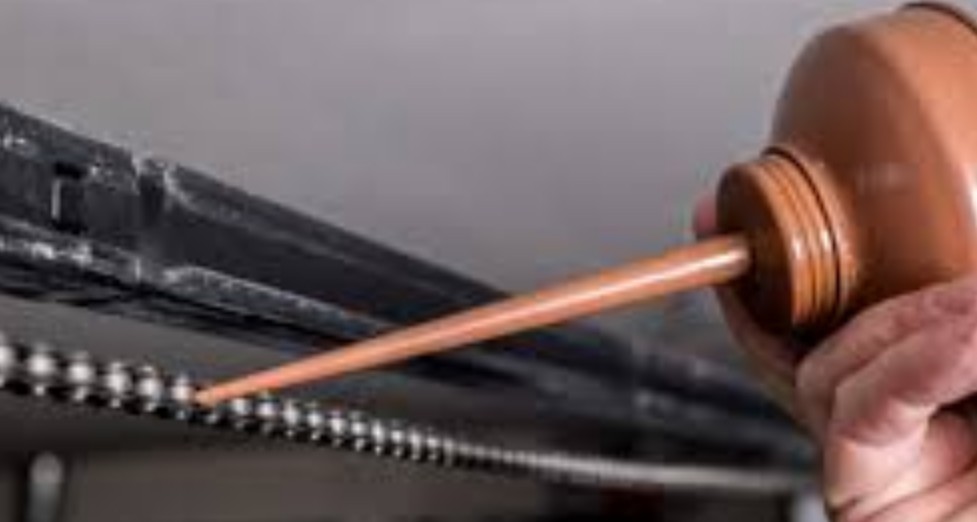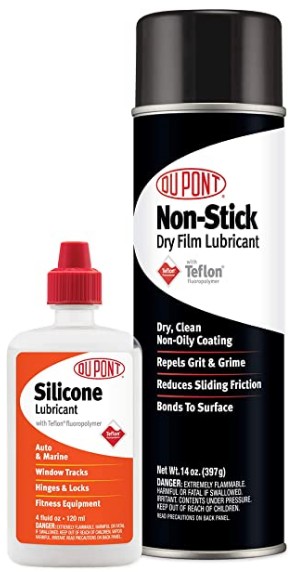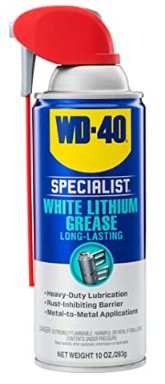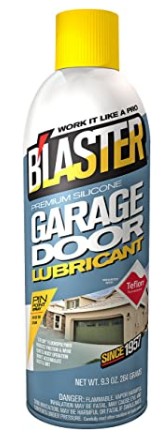How to Lubricate a Garage Door
Lubrication is the most crucial part of garage door maintenance. Although garage door models are different, they all have moving parts that require lubrication now and again. If your garage door produces a loud grinding or squeaking noise, or if the door mechanism is not working smoothly, your garage door probably requires lubrication.
Garage doors have multiple moving parts during operation. When these parts move, they grind against each other and cause friction which causes wear and tear of these parts and loud noises. To fix this, spray some garage door lubricant onto all moving parts to prevent damaging your door. Our article will guide you on how and where to lubricate your garage door and what lubricants are suitable for garage doors.
Steps to lubricate a garage door
Follow the guide below on how to lubricate your garage door properly.
Things you need
- Lithium-based or silicon-based garage door lubricant
- Clean rag
- Ladder
- Shop-vac
Directions
1. Choose the best garage door lubricant.
The best lubricant for garage doors is a silicone-based or lithium-based spray. Do not use mechanic’s grease or engine oil on your garage door because they attract dust and grime, which damages the garage door in the long run.
Check the recommendations at the end of the guide to see the best garage door lubricants
2. Prep the garage door for lubrication.
- Put your garage door opener on manual mode and put it in the “closed” position.
- Tighten every nut and bolt on your garage door until they are snug. Do not over-tighten them.
- Look for worn parts and replace them if necessary.
- Tighten the garage door opener chain because it makes a slapping sound and causes the door to wiggle around when the chain is loose.
- Switch off power to the garage door opener to prevent it from opening while you lubricate its parts.
- Use a damp rag and wipe out any dust and dirt along the tracks to ensure the door opens smoothly.
- If there is dirt in the hard-to-reach areas of the tracks, use a shop vac to remove the debris and dirt. The tracks do not need lubrication, only cleaning.
3. Lubricate the hinges.
- Slowly lift the garage door open while spraying the lubricant onto the hinges as they bend on the track. Be generous with the lubricant, making sure the product covers the hinges.
- Lubricate the rollers.
- Locate the rollers, the circular objects on the hinges on the side of your garage door that move when the garage door moves. These rollers have small ball bearings inside them that allow the garage door to move up and down. These ball bearings require lubrication.
- Attach a hose to the can’s nozzle and carefully spray the lubricant inside the rollers to get to the ball bearings inside. While spraying, you should avoid getting lubricant on the nylon rollers. Then wipe out any excess lubricant to prevent your door from becoming unbalanced.
4. Lubricate the springs and bearing plates.
- Locate the springs at the top of the garage door, and the bearing plates are the circular discs on both sides of the springs. Inspect the condition of the spring before spraying them. If they are damaged or warped, you need to replace them. Using a garage door with disfigured springs is dangerous as it can snap out and injure someone.
- Apply the lubricant onto the exterior of the torsion springs and the center of the bearing plates.
- Open and close your garage door manually several times to spread the grease through the garage door system.
5. Lubricate the top of the rail.
- Locate the rail, which is the part that houses the chain.
- Lubricate the top of the rail, then spread the grease around the area with a clean rag to ensure it distributes evenly. For the railing, you should consult your garage door contact or user manual about lubricating it since brands can vary.
6. Lubricate the locks.
- Close the door to access the locks and armbar. The spray lubricant on the garage door lock to make the locking smoother also prevent rust. It is best to also spray the armbar at the top of the garage door. Finally, apply some lubricant into the keyhole, ensuring it spreads into the lock system’s tumbler and other moving parts.
7. Test the garage door.
- Connect the garage door opener to power, disengage manual mode, and open and close the garage door several times to ensure even distribution of the lubricant.
- Listen for any significant amount of noise. If there is still noise, the parts are not well lubricated, or it could indicate a damaged component that requires replacing.
How often should you lubricate a garage door?
We recommend lubricating all the moving parts in your garage door every three to six months to extend your garage door’s lifespan and keep it quiet. With heavy use of if you live in extreme climates, you should lubricate your garage door more frequently. It is also essential to ensure you’re using an all-weather lubricant. Cold temperatures thicken the lubricant and make it harder to open and close the garage door.
If you hear a grinding or creaking sound or the garage door is not moving smoothly, this is a sign to apply some lubricant to your garage door.
Signs that it’s time to lubricate your garage door
Keeping your garage door well maintained throughout is important to prolong its lifespan and avoid a noisy garage door. Avoiding to lubricate will increase friction around moving parts and cause those parts to wear down quickly, which leads to pricey repairs. So here are the signs to look out for when it’s time to lubricate your garage door.
1. A very noisy garage door
Garage doors are not the quietest during regular operation, but it probably requires lubrication if you hear loud screeching, banging, or rattling sounds. The noises are probably coming from the hinges, tracks, wheels, and springs of your garage door, which require lubrication. You should also lubricate the lock and the gears inside the tumbler.
2. The garage door is moving too slowly.
Lubricating all the moving parts on your garage door allows for smooth operation. So if your garage door happens to be closing and opening too slowly, it indicates insufficient lubrication.
3. The garage door jerks when closing.
In normal conditions, the garage door usually experiences some movement. However, excessive shaking and shuddering could be a sign of dry rollers or hinges. If you have not lubricated your garage door in a while, the rollers can come off the track, making it dangerous to operate your garage door. Repair the issues and lubricate all the moving parts.
4. Broken garage door springs
The springs control the weight of your door to make sure it opens and closes properly. If your garage door fails to open and close smoothly, there is most likely a broken spring. A broken spring is a sign of infrequent lubrication, which causes the spring to wear out and snap. Call a garage door technician to replace the broken spring and then maintain regular lubrication to increase their lifespan.
What parts of a garage door should you lubricate?
Essentially, you should lubricate any moving part in your garage door system. The lubricant allows the moving parts to glide more smoothly over each other and reduce wear and tear. The parts of a garage door to lubricate include:
- Hinges: They are on the inside of the door; they connect the door sections and allow the door to bend as it opens.
- Rollers: Their purpose is to roll up the garage door up and down the track with the help of the torsion springs. Be careful not to over-saturate the rollers with lubricant and wipe away any excess product. Here’s how to lubricate different types of garage door rollers:
- Plastic rollers: Apply the lubricant on the outside of the roller where the shaft meets the roller.
- Steel rollers: Apply the lubricant to the ball bearings inside the roller where it meets the shaft.
- Nylon rollers with exposed ball bearings: Apply lube onto the ball bearings.
- Nylon rollers without ball bearings: Apply lubricant on the exterior of the roller.
- Nylon rollers with sealed ball bearings: Do not lubricate, and it does not require any maintenance.
- Torsion springs: The torsion springs wind and unwinds to help with the opening and closing of the garage door and store the energy needed to lift the door’s weight. Lubricating the springs is essential as it preserves their integrity and prevents them from breaking.
- Bearing plates or brackets: These are at the end of the pole that holds the torsion springs to prevent the bar from falling out. Lubricating the center of the bearing plates prevents the bar from rubbing against the bracket during operation, forming grooves in the torsion shaft.
- Garage door opener drive: If your garage door opener has a screw drive or a chain drive, remember to lubricate the screw or chain.
- Locks: Lubricating the lock system on the garage door will prevent your key from getting stuck.
- Tracks: Do not lubricate your garage door tracks, or they will collect dust, preventing the rollers from moving freely and making the opener work harder to lift the garage door. Instead, you need to wipe the tracks with a damp cloth to remove dirt and debris for your rollers to move smoothly. To loosen any stuck grime, apply some automotive brake cleaner or grease cleaner like WD-40.
What should I use to lubricate my garage door?
The purpose of lubricating a garage door is to protect the metal parts from friction, reduce oxidation and keep the effects of moisture at bay. However, using the right product on your garage door is very crucial. The best garage door lubricant should be silicone-based or lithium-based.
Silicon-based lubricants: This product is a heavy-duty garage door lubricant because it is long-lasting. They come in an aerosol spray can, which allows the product to get to hard-to-reach areas. In addition, they are waterproof, weather-resistant, and great for extreme weather such as during winters and summers.
Lithium-based lubricants: These products coat the surface instead of penetrating the parts, making them suitable for lubricating rollers, rails, and other metal-on-metal parts. These lubricants are weather resistant but are not waterproof.
Best garage door lubricants
Below are some of our best garage door lubricants for smooth and silent operation in the market right now.
DuPont Teflon silicon lubricant aerosol spray
The DuPont Teflon silicon lubricant light-duty silicone-based product lubricates and protects materials other than metal. It has a formula that works with rubber, vinyl, leather, wood, metal. Therefore it will not corrode the non-metal parts of your garage door. In addition, it is water-resistant and prevents rust and corrosion on all types of metals.
Features
- Dimension: Not Listed
- Volume: 14 fluid ounces
- Waterproof: Yes
- Surface: Metal, Non-Metal
- Silicon-based with Teflon Fluoropolymer
- Effective in extreme temps from -40°F to 400° F.
Pros
- It evaporates into a non-oily layer.
- Reduces friction and stops the garage door from squeaking.
- It prevents and also reduces rust and corrosion.
- It works with other non-metal surfaces.
Cons
- It is only for light-duty purposes.
- It can be runny and messy due to its light consistency.
- Some customers complain the spraying straw does not fit into the nozzle hole.
- It is not very long-lasting since it leaves a very light coat after drying.
WD-40 300240 Specialist White Lithium Grease Spray
The WD-40 White Lithium Grease is the lubricant of choice for high-load parts like bearings, axles, and torsion springs. It comes in an aerosol can with a long nozzle to help direct the product in tight spaces and crannies. The White lithium looks liquid, but it sets in place quickly and evenly, creating a
greasy barrier between moving parts. As a result, it is suitable for gears, hinges, tracks, and pulleys. It also requires a light-handed application to work; therefore, you can make the most out of one can of product.
Features
- Dimension: Not Listed
- Volume: 10 Fluid Ounces
- Waterproof: No
- Surface: Metal
- White lithium
- Temperature rating: 0°F to 300° F.
Pros
- It has an easy application nozzle.
- It effectively lubricates metal parts and removes noise on garage doors.
Cons
- It corrodes rubber and vinyl parts,
- Strong odor
- Produces pungent fumes during application- Keep the windows and doors open during application for proper ventilation.
Blaster Garage Door Lubricant
This product is a silicone-based lubricant that leaves a tack-free coating that does not accumulate dust and dirt. Blaster works well on both auto and manual-open garage doors. It is an excellent lubricant for the garage door’s chains, roller bearings, rollers, rails, screw drives, torsion springs, hinges, and pulleys. The Blaster garage door lubricant eliminates rusting and provides lubrication for corroded surfaces. Also, it is waterproof and weather-resistant during extreme temperatures and humidity.
Features
- Dimension: 7.75 x 2.75 x 2.75 inches
- Weight: 9.3 fluid Ounces
- Waterproof: Yes
- Surface: Metal and Non-metal
- Silicon-based with Teflon Fluoropolymer
- Temperature rating: 54°F
Pros
- It dries quickly.
- It quiets noisy garage door operation.
- It applies thinly but has long-lasting lubrication.
- It is resistant to dust and dirt since it dries quickly.
- Reduces friction and protects metal parts from moisture damage.
Cons
- It produces strong fumes.
- Its application is not precise and drips a lot.
- You have to shake it vigorously before applying because the silicon settles at the bottom.
Is silicone lubricant good for garage doors?
Yes, silicone-based spray lubricant is an excellent product to use on the moving parts of your garage doors. It also reduces friction and prevents wear and tear of metal parts and other non-metal parts. It removes moisture from surfaces and prevents rusting and corrosion. You do not have to worry about silicone lubricant spreading to other non-metal parts of your garage door as it does not cause corrosion like lithium-based lube. So it protects other parts of your garage door other than the metal ones.
Silicone lubricant is not tacky, so it does not attract dust, dirt, and grime to stick; therefore, it also prevents parts from sticking and binding. The product flows easily into nooks and crannies between the rollers and hinges to enable smooth garage door operation.
Is WD40 OK to use on garage doors?
You should not use WD-40 on your garage door as it is not an actual lubricant. WD-40 is a light household product containing mineral spirits, mineral oils, and carbon dioxide. Although WD40 does help metal parts move more smoothly, it works more as a cleaner and grease cutter than a lubricant.
Check this too: What is the Best Way to Insulate a Garage Door?
WD-40 is not powerful enough to lubricate a garage door mechanism that lifts over a hundred pounds of metal. It also evaporates too quickly; within a week after application, it leaves a very thin layer of mineral oil that is insufficient to lubricate the garage door parts. You would find you have to apply it too often to solve the issue.
Conclusion
Maintaining your garage door involves regularly lubricating all the moving parts and using the proper garage door lubricant. Using the wrong lubricant can even cause more damage to the garage door. Preferably, spray your silicone or lithium lubricant on the hinges, locks, rollers, ball bearings, torsion springs, and garage door opener drive of your garage door every three to six months or more. Regular lubrication ensures smooth operation, eliminates noise, and preserves your garage door parts.





